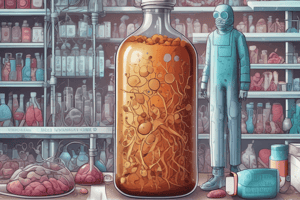Podcast
Questions and Answers
What information must be included on a specimen label?
What information must be included on a specimen label?
What procedure should be followed if multiple containers are used for specimen collection?
What procedure should be followed if multiple containers are used for specimen collection?
Which of the following is NOT one of the four patient 'rights' to consider when collecting blood specimens?
Which of the following is NOT one of the four patient 'rights' to consider when collecting blood specimens?
What is an essential precaution to take before performing a venipuncture?
What is an essential precaution to take before performing a venipuncture?
Signup and view all the answers
Why might a client's specimen be rejected by the laboratory?
Why might a client's specimen be rejected by the laboratory?
Signup and view all the answers
What is the primary use of the lavender top blood collection tube?
What is the primary use of the lavender top blood collection tube?
Signup and view all the answers
Which tube is suitable for obtaining prothrombin time (PT)?
Which tube is suitable for obtaining prothrombin time (PT)?
Signup and view all the answers
What is the effect of delayed centrifugation on serum samples?
What is the effect of delayed centrifugation on serum samples?
Signup and view all the answers
What additive is found in dark green top blood collection tubes?
What additive is found in dark green top blood collection tubes?
Signup and view all the answers
What is primarily preserved in light gray top tubes using sodium fluoride and potassium oxylate?
What is primarily preserved in light gray top tubes using sodium fluoride and potassium oxylate?
Signup and view all the answers
Study Notes
Specimen Labeling Requirements
- All specimen tubes/containers must be labeled with the patient's name, date and time of collection, and initials of the person collecting the specimen.
- If multiple specimens are collected, each must have a separate label specifying its source or type.
- For multiple containers (e.g., 24-hour urine), label each container with a unique identifier (e.g., 1 of 2, 2 of 2).
- The person collecting the specimen should complete the labeling.
- Specimens not properly labeled will be rejected. Clients will be notified of any errors.
Blood Collection Guidelines
- Blood specimens are collected routinely for laboratory testing, often by venipuncture (peripheral vein).
- Universal precautions (gloves, masks, gowns, eye protection, good hand hygiene) minimize health care worker exposure risk.
- Prior to specimen collection, assess patient factors (meds, pregnancy, age, sex) and ensure they've followed any special instructions (fasting, specific medication timing).
- Four "rights" of specimen collection: Right specimen (confirm with order), Right time (e.g., trough/peak levels), Right patient (verify ID, label), Right method (universal precautions).
Blood Collection Tubes
- Blood collection tubes come in various colored stoppers, each with potential additives (e.g., anticoagulants).
- Red top: no additives, used for various tests.
- Tiger top/serum separator tube (SST): contains a polymergel and clot activator; serum separation upon centrifugation.
- Lavender top: contains EDTA, used for complete blood counts.
- Dark green top: contains heparin, used for lithium and ammonia levels.
- Light blue top: contains sodium citrate; used for PT/PTT.
- Light gray top: contains sodium fluoride/potassium oxalate, used for glucose preservation.
- Specimens are typically processed into plasma, serum, or anticoagulated whole blood.
Bloodstream Infections
- Bacteremia: bacteria in the blood.
- Fungemia: fungi in the bloodstream.
- Septicemia: bloodstream infection with bacterial multiplication and toxin production.
- Common causative organisms in catheter-related bloodstream infections are gram-positive organisms (coagulase-negative staphylococci, S. aureus, and enterococci).
- Adequate blood volume collection is crucial for accurate results. Separate samples for blood cultures to reduce risk of false-positives.
- Blood Culture procedures should follow standard protocols for collection, timing, and labeling to optimize results.
- Additional tests and identification methods are typically necessary for identifying specific organisms.
- If suspect organisms are unusual, a clear communication with lab techs will increase diagnostic accuracy.
Studying That Suits You
Use AI to generate personalized quizzes and flashcards to suit your learning preferences.
Related Documents
Description
Test your knowledge on the essential guidelines for specimen labeling and blood collection. This quiz covers critical practices to ensure accurate specimen handling and compliance with safety protocols. Enhance your understanding of proper procedures and improve laboratory practices.




